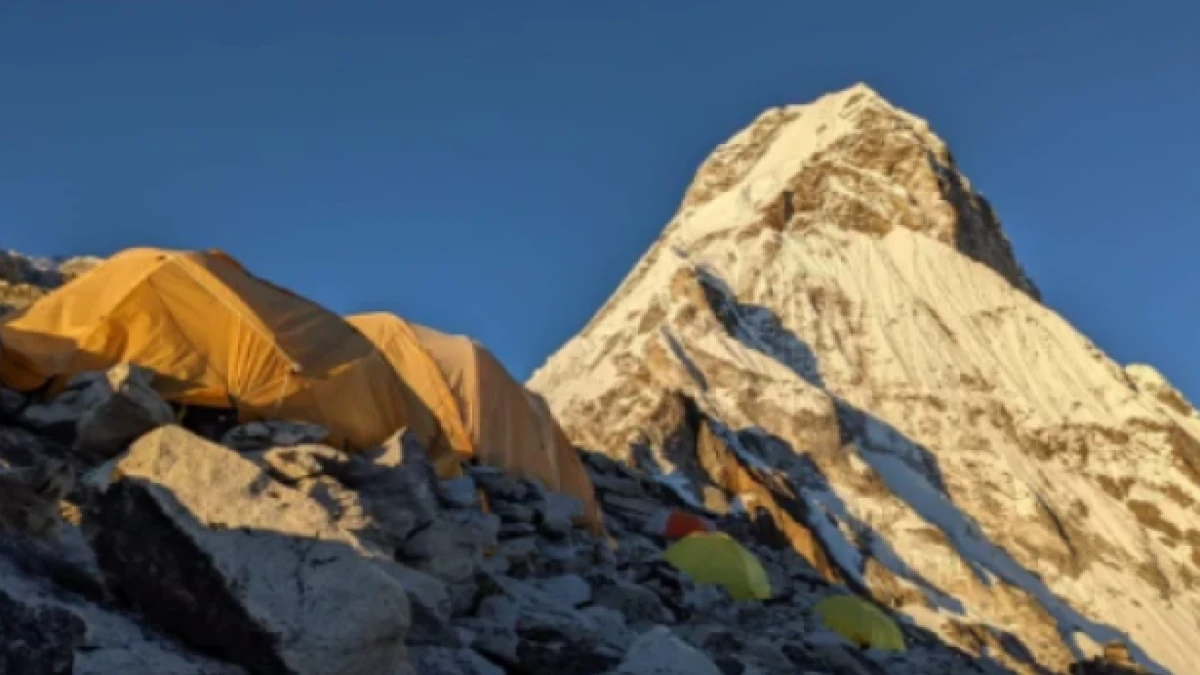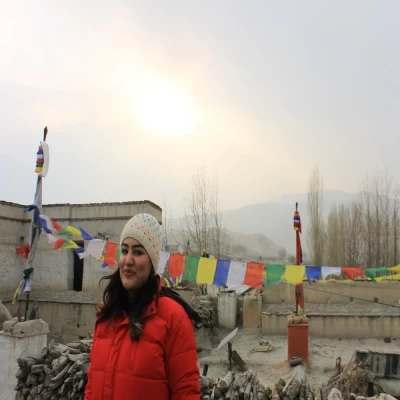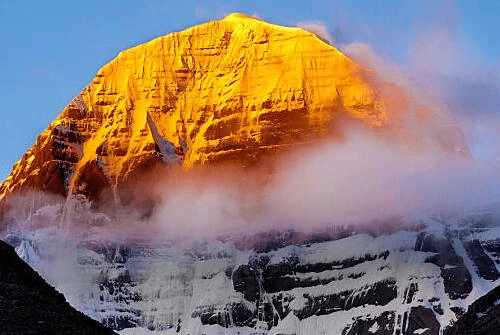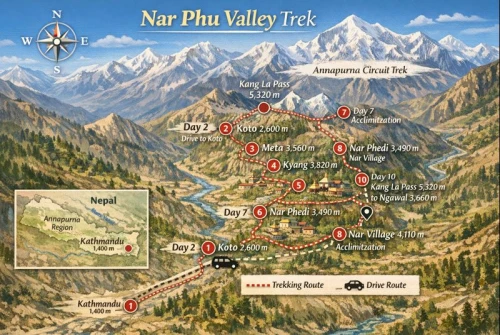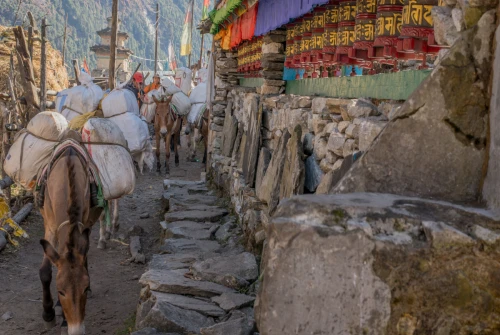Lobuche Peak Climbing is one of the most thrilling and rewarding adventures in the Himalayas, offering a unique opportunity to summit a 6,119-meter peak while exploring the iconic trails of the Everest region. Located close to the Khumbu Glacier and near Everest Base Camp, Lobuche East presents an ideal challenge for trekkers looking to transition into mountaineering. With breathtaking panoramic views of Everest, Lhotse, Nuptse, and Ama Dablam, this climb delivers not only high-altitude thrills but also unforgettable scenery that stays etched in memory forever.
What makes Lobuche Peak stand out is its combination of accessible adventure and genuine alpine challenge. While it is considered a trekking peak, Lobuche East involves steep snow slopes, technical ridges, and a final ice section that demands the use of fixed ropes and climbing equipment. It is perfect for fit and adventurous travelers who want to go beyond trekking without committing to a full expedition climb. The journey typically follows the Everest Base Camp trail, allowing for excellent acclimatization and cultural immersion before the summit attempt begins.
Beyond the climb itself, Lobuche Peak offers a deeper connection to the Khumbu region's spiritual and cultural richness. As we pass through ancient Sherpa villages, visit sacred monasteries like Tengboche, and share stories with local guides and climbers, we become part of a larger Himalayan experience. Whether you’re seeking your first Himalayan summit or aiming to add a new peak to your climbing résumé, Lobuche Peak promises a professionally guided, soul-stirring journey above the clouds.
Where is Lobuche Peak Located?
Lobuche Peak is located in the Solukhumbu District of Nepal, deep within the Sagarmatha National Park, a region world-renowned for being home to Mount Everest and many of the world's tallest peaks. Specifically, it lies near the village of Lobuche, not far from the Khumbu Glacier and Everest Base Camp. This proximity to the iconic trekking routes and stunning glacier landscapes makes Lobuche Peak one of the most accessible and scenic climbing peaks in Nepal.
The area surrounding Lobuche is dotted with high-altitude Sherpa villages, sacred monasteries, and endless panoramas of the towering Himalayas. Climbing Lobuche East offers not only an adrenaline-filled adventure but also the chance to experience the legendary hospitality and deep spiritual culture of the Khumbu region. As you trek toward the base of the mountain, you’ll follow the same trails taken by Everest summiteers, adding historical and emotional depth to your journey.
What Makes Lobuche Peak Climbing Special?
What makes Lobuche Peak truly stand out is the breathtaking combination of alpine adventure and accessible technicality. For climbers seeking to transition from trekking to mountaineering, Lobuche East offers an ideal introduction to high-altitude peak climbing. It features snow ridges, steep ice slopes, and rocky terrain that offer just enough challenge to feel like a true expedition—without requiring professional-level skills.
The views from the summit are nothing short of phenomenal. As we stand atop Lobuche East, a sweeping panorama of some of the most iconic peaks in the world unfolds—Mount Everest, Lhotse, Nuptse, Ama Dablam, Pumori, and even Makalu in the distance. These are not just names on a map but legendary giants of the Himalayas, each commanding awe and reverence. Very few trekking peaks provide such cinematic rewards with a relatively short climbing window and logistical simplicity.
Lobuche East vs. Lobuche West: Which One Should You Climb?
Lobuche Peak consists of two distinct summits: Lobuche East (6,119 meters) and Lobuche West (6,145 meters). While they are geographically close, the experiences they offer are vastly different. Lobuche East is the designated "trekking peak" and is permitted through the Nepal Mountaineering Association (NMA). It is popular among adventure travelers and aspiring climbers due to its achievable difficulty, structured permit process, and inclusion in guided itineraries.
On the other hand, Lobuche West is more remote and technically demanding. It is classified as an "expedition peak," meaning that it requires a separate, more expensive permit and usually a higher level of technical expertise, including the ability to handle sustained mixed climbing. Most agencies do not offer standard group packages to Lobuche West, and it's often approached by experienced alpinists who may use it for training before attempting higher and more difficult mountains.
For the vast majority of trekkers and climbers, Lobuche East is the logical and rewarding choice. It gives us a real taste of Himalayan climbing without overwhelming risk or complex logistics. For those seeking an intense technical challenge, Lobuche West awaits, but with significantly more preparation.
How Difficult is Lobuche Peak Climbing?
Lobuche East is not just a walk-up; it demands a decent level of fitness and mountaineering awareness. The climb is rated PD+ (Peu Difficile plus) on the Alpine Grading System, which translates to "a little difficult." That might sound modest, but at over 6,000 meters, every step becomes a challenge due to low oxygen levels and unpredictable Himalayan weather. The climb from high camp to the summit involves steep sections of ice and snow where fixed ropes and crampons are used.
Physically, climbers must be ready for long hours of ascent—often 8 to 10 hours on summit day, which starts well before dawn. Technically, you’ll need to be comfortable walking with crampons, using an ice axe, and handling harnesses and ascenders. There’s also a short but sharp ice wall near the summit, where climbers ascend using jumar and fixed lines. While no previous high-altitude summit is strictly required, having experience above 5,000 meters is strongly recommended.
The real challenge, however, is not just the climb itself but the thin air and freezing temperatures. Proper acclimatization, good guiding, and sound mental preparation are crucial to success and safety on Lobuche Peak.
Best Time to Climb Lobuche Peak
Lobuche Peak is best climbed during the two pre-monsoon and post-monsoon seasons—spring (March to May) and autumn (September to November). During these times, weather patterns in the Everest region tend to be stable, and skies remain mostly clear, offering the best conditions for both trekking and climbing.
Spring is a particularly attractive time, with rhododendron forests blooming during the early trail sections and warmer daytime temperatures in the higher elevations. Snow conditions are generally good, and summit success rates are high. Autumn offers even better visibility, as the monsoon clears the dust from the air, giving crisp views of the peaks and valleys. The nights can be colder than spring, but the chance of precipitation is lower, making it a favorite among many climbers.
Attempting the climb during winter (December to February) brings extreme cold, strong winds, and heavy snowfall, which can make the climb more technical and risky. Summer (June to August), dominated by the monsoon, is also not recommended due to heavy rainfall, leech-infested trails in the lower region, and poor visibility.
Standard Itinerary for Lobuche Peak Climb
The itinerary for Lobuche Peak usually spans 16 to 18 days, designed with acclimatization in mind. The initial days follow the Everest Base Camp trekking route, allowing climbers to gain altitude gradually. This serves as both a physical and mental preparation for the summit.
The trek begins with a flight to Lukla and a gradual ascent through the beautiful Sherpa villages of Phakding, Namche, Tengboche, and Dingboche. These villages offer stunning views, cultural encounters, and restful teahouses. After reaching Everest Base Camp and Kala Patthar, we descend to Lobuche Base Camp to begin the summit push. This route ensures maximum acclimatization, significantly reducing the chances of altitude sickness.
The summit push typically starts from High Camp at around 5,400 meters. Climbers leave around 1–2 AM, reaching the summit between 7–9 AM if conditions are favorable. After a short stay at the summit for photos and celebration, we descend back to High Camp or even lower, depending on the team's energy and weather.
Accommodation and Food on the Trail
Accommodation during the trek up to Lobuche Base Camp consists of comfortable teahouses. These lodges, run by local Sherpa families, offer basic but warm hospitality with twin rooms, shared bathrooms, and hearty meals. You’ll enjoy staple Nepali meals like dal bhat (rice, lentils, and vegetables), as well as pasta, pancakes, momos, fried rice, and soups.
Once we leave the teahouses and move to Base Camp and High Camp, accommodation shifts to tented camping. Here, your climbing crew sets up sleeping tents, kitchen tents, and even a dining tent. While the conditions are more basic, meals remain nourishing and high in calories, perfect for energy at high altitudes. Clean drinking water, boiled or treated, is always provided to ensure hydration and hygiene.
Permits Required for Lobuche Peak
To legally climb Lobuche East, climbers are required to obtain several permits, each serving a specific function in conservation, regulation, and access. The most crucial one is the Lobuche Peak Climbing Permit, issued by the Nepal Mountaineering Association (NMA). The cost varies by season: USD 250 in spring, USD 125 in autumn, and just USD 70 in winter or summer.
In addition to the climbing permit, you’ll need the Sagarmatha National Park Entry Permit (NPR 3,000), which allows access to the protected region of the Khumbu, and the Khumbu Pasang Lhamu Rural Municipality Permit (NPR 2,000), which supports local infrastructure. The TIMS card is optional if you are trekking with a registered agency.
These permits can be acquired by yourself in Kathmandu or arranged seamlessly through a trekking agency. Having all your paperwork in order is essential, as there are multiple checkpoints along the trail.
What Gear and Equipment Do You Need?
Lobuche Peak is a technical climb, requiring proper mountaineering gear to ensure safety and performance. Essential personal climbing gear includes B2 or B3 double boots, crampons, a climbing harness, helmet, ice axe, ascender/descender devices, carabiners, and fixed-line compatible gloves. Without the correct gear, the icy summit ridge and fixed rope sections can become dangerous.
On top of climbing tools, you’ll also need warm, layered clothing: moisture-wicking base layers, fleece mid-layers, waterproof shell jackets, insulated down jackets, windproof pants, and gloves rated for extreme cold. A sleeping bag rated to -20°C, a sturdy backpack, headlamp, and hydration system are also must-haves.
Most of the gear can be rented in Kathmandu or Namche, but for comfort and safety, we always recommend bringing your essentials especially boots and outerwear.
Do You Need a Guide for Lobuche Peak?
Yes, it’s strongly advised and often mandatory to climb with a certified climbing guide or agency. Even if you have previous mountaineering experience, the logistics, high altitude, and rapidly changing Himalayan weather require expert handling. Local guides are familiar with the terrain and can make critical decisions about timing, safety, and route conditions.
Guides and Sherpa support teams will assist with everything from rope fixing and load carrying to cooking and campsite setup. Their deep knowledge of the mountains, combined with cultural insight and first-aid training, adds not just to your safety but your overall experience. Many climbers report that forming a bond with their Sherpa guides becomes a highlight of the trip.
Health, Safety, and Altitude Risks
At elevations above 4,000 meters, altitude sickness becomes a real risk. Symptoms can range from headaches and nausea to dangerous conditions like HAPE or HACE. Following a well-designed acclimatization schedule is key, as is recognizing early symptoms. Most itineraries include rest days at Namche and Dingboche, helping your body adjust to the lower oxygen levels. Climbers are encouraged to carry altitude medication like Diamox, stay hydrated, and sleep at lower altitudes when possible. Your guides will regularly check oxygen levels using a pulse oximeter, and most agencies are equipped to arrange emergency helicopter evacuations, which are covered by travel insurance with the right policy.
Cultural Highlights Along the Trail
The route to Lobuche Peak is more than just a physical journey; it’s a deep cultural immersion into the Sherpa heartland. We pass through villages like Namche Bazaar, the trading capital of the Khumbu, and Tengboche, home to the region’s largest monastery. Monks here often bless climbers before their summit attempt, a spiritual tradition that many find deeply grounding. From prayer flags fluttering in the wind to Mani walls etched with Tibetan Buddhist prayers, the trail is rich in religious symbolism. As you interact with local people, you'll notice their humility, strength, and profound connection to the mountains' qualities that have helped Sherpas become legendary mountaineers.
Why Combine Lobuche Climb with Everest Base Camp Trek?
Combining Lobuche Peak with the Everest Base Camp trek gives you the ultimate Himalayan adventure. As we ascend through the EBC trail, our bodies adapt to the altitude, increasing our chances of a successful summit. Emotionally, visiting EBC, where so many mountaineering legends have launched their journeys, adds immense inspiration to your own climbing experience.
Standing on Kala Patthar offers a dramatic preview of Everest, while summiting Lobuche gives you a mountaineer’s perspective of the Khumbu. Together, these two destinations create an unforgettable loop of trekking, climbing, culture, and adventure, all in one perfectly curated journey.
